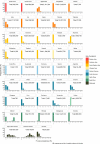Global estimates of pregnancies at risk of Plasmodium falciparum and Plasmodium vivax infection in 2020 and changes in risk patterns since 2000
- PMID: 36962612
- PMCID: PMC10022219
- DOI: 10.1371/journal.pgph.0001061
Global estimates of pregnancies at risk of Plasmodium falciparum and Plasmodium vivax infection in 2020 and changes in risk patterns since 2000
Abstract
Background: Women are at risk of severe adverse pregnancy outcomes attributable to Plasmodium spp. infection in malaria-endemic areas. Malaria control efforts since 2000 have aimed to reduce this burden of disease.
Methods: We used data from the Malaria Atlas Project and WorldPop to calculate global pregnancies at-risk of Plasmodium spp. infection. We categorised pregnancies as occurring in areas of stable and unstable P. falciparum and P. vivax transmission. We further stratified stable endemicity as hypo-endemic, meso-endemic, hyper-endemic, or holo-endemic, and estimated pregnancies at risk in 2000, 2005, 2010, 2015, 2017, and 2020.
Findings: In 2020, globally 120.4M pregnancies were at risk of P. falciparum, two-thirds (81.0M, 67.3%) were in areas of stable transmission; 85 2M pregnancies were at risk of P. vivax, 93.9% (80.0M) were in areas of stable transmission. An estimated 64.6M pregnancies were in areas with both P. falciparum and P. vivax transmission. The number of pregnancies at risk of each of P. falciparum and P. vivax worldwide decreased between 2000 and 2020, with the exception of sub-Saharan Africa, where the total number of pregnancies at risk of P. falciparum increased from 37 3M in 2000 to 52 4M in 2020.
Interpretation: Historic investments in malaria control have reduced the number of women at risk of malaria in pregnancy in all endemic regions except sub-Saharan Africa. Population growth in Africa has outpaced reductions in malaria prevalence. Interventions that reduce the risk of malaria in pregnancy are needed as much today as ever.
Copyright: © 2022 Gore-Langton et al. This is an open access article distributed under the terms of the Creative Commons Attribution License, which permits unrestricted use, distribution, and reproduction in any medium, provided the original author and source are credited.
Conflict of interest statement
The authors have declared that no competing interests exist.
Figures




Similar articles
-
Global estimates of the number of pregnancies at risk of malaria from 2007 to 2020: a demographic study.Lancet Glob Health. 2023 Jan;11(1):e40-e47. doi: 10.1016/S2214-109X(22)00431-4. Lancet Glob Health. 2023. PMID: 36521951 Free PMC article.
-
Quantifying the number of pregnancies at risk of malaria in 2007: a demographic study.PLoS Med. 2010 Jan 26;7(1):e1000221. doi: 10.1371/journal.pmed.1000221. PLoS Med. 2010. PMID: 20126256 Free PMC article.
-
Mapping the global prevalence, incidence, and mortality of Plasmodium falciparum and Plasmodium vivax malaria, 2000-22: a spatial and temporal modelling study.Lancet. 2025 Mar 22;405(10483):979-990. doi: 10.1016/S0140-6736(25)00038-8. Epub 2025 Mar 5. Lancet. 2025. PMID: 40056919 Free PMC article.
-
Folic acid supplementation and malaria susceptibility and severity among people taking antifolate antimalarial drugs in endemic areas.Cochrane Database Syst Rev. 2022 Feb 1;2(2022):CD014217. doi: 10.1002/14651858.CD014217. Cochrane Database Syst Rev. 2022. PMID: 36321557 Free PMC article.
-
Risk of Plasmodium vivax parasitaemia after Plasmodium falciparum infection: a systematic review and meta-analysis.Lancet Infect Dis. 2019 Jan;19(1):91-101. doi: 10.1016/S1473-3099(18)30596-6. Lancet Infect Dis. 2019. PMID: 30587297 Free PMC article.
Cited by
-
Individual and community-level correlates of optimal doses of sulfadoxine-pyrimethamine for intermittent preventive treatment of malaria during pregnancy in Tanzania: a multilevel analysis of the 2022 national survey.Malar J. 2025 Jul 23;24(1):240. doi: 10.1186/s12936-025-05482-8. Malar J. 2025. PMID: 40702459 Free PMC article.
-
Prevalence and determinants of anaemia among pregnant women in a high malaria transmission setting: a cross-sectional study in rural Burkina Faso.Pan Afr Med J. 2024 Jan 3;47:2. doi: 10.11604/pamj.2024.47.2.40612. eCollection 2024. Pan Afr Med J. 2024. PMID: 38371648 Free PMC article.
-
Current Status of Malaria Control and Elimination in Africa: Epidemiology, Diagnosis, Treatment, Progress and Challenges.J Epidemiol Glob Health. 2024 Sep;14(3):561-579. doi: 10.1007/s44197-024-00228-2. Epub 2024 Apr 24. J Epidemiol Glob Health. 2024. PMID: 38656731 Free PMC article. Review.
-
Sub-microscopic Plasmodium falciparum parasitaemia, dihydropteroate synthase (dhps) resistance mutations to sulfadoxine-pyrimethamine, transmission intensity and risk of malaria infection in pregnancy in Mount Cameroon Region.Malar J. 2023 Mar 2;22(1):73. doi: 10.1186/s12936-023-04485-7. Malar J. 2023. PMID: 36864514 Free PMC article.
-
Development of a rapid malaria LAMP-MS assay for diagnosis of malaria infections.Sci Rep. 2025 Mar 12;15(1):8547. doi: 10.1038/s41598-025-92935-4. Sci Rep. 2025. PMID: 40074752 Free PMC article.
References
-
- Katz J, Lee AC, Kozuki N, Lawn JE, Cousens S, Blencowe H, et al.. Mortality risk in preterm and small-for-gestational-age infants in low-income and middle-income countries: a pooled country analysis. Lancet (London, England). 2013;382(9890):417–25. doi: 10.1016/S0140-6736(13)60993-9 - DOI - PMC - PubMed
Grants and funding
LinkOut - more resources
Full Text Sources
Miscellaneous
